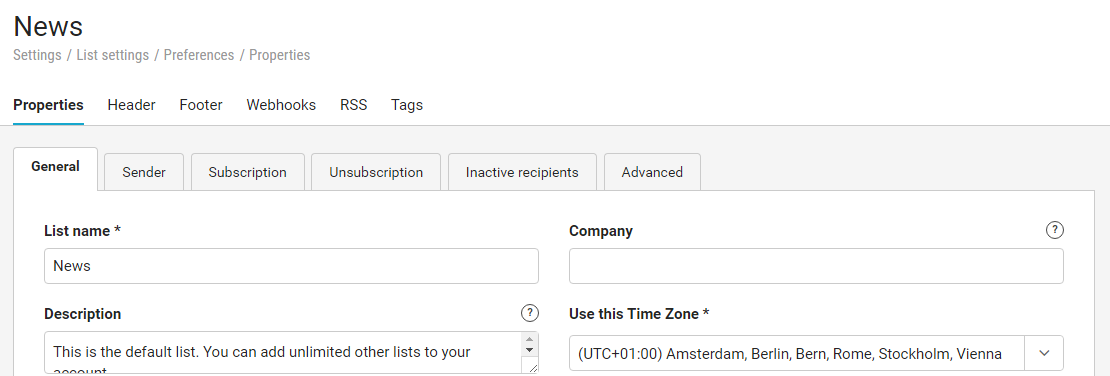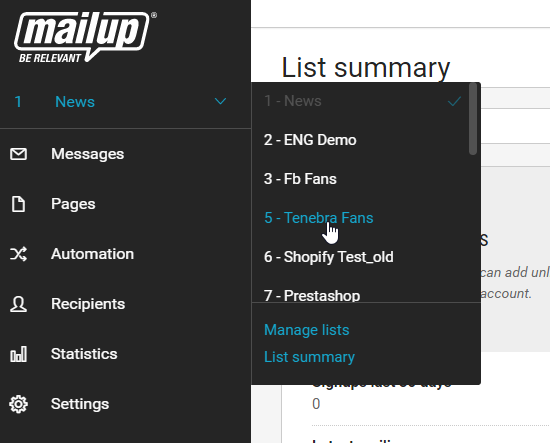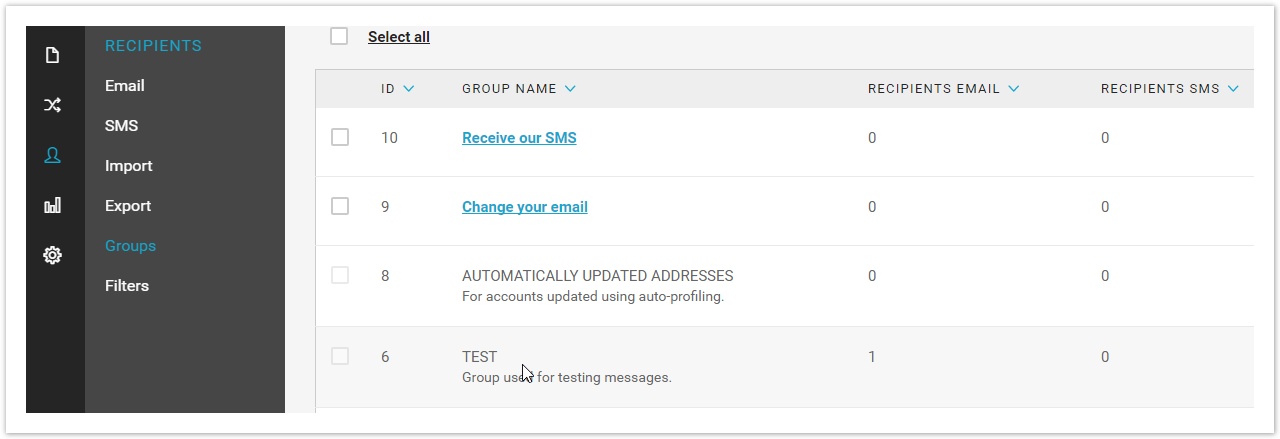Getting Started
Welcome to MailUp!
Just a Trial User? Remember to follow these steps on the MailUp Console:
1) Create your settings: "SETTINGS > EDIT LISTS"
2) Import your contacts (25 max for Trial Users!): "RECIPIENTS > IMPORT"
3) Create your trial email: "EMAIL > NEW" *....... and Send!
*You may choose to do a more advanced trial and peruse of the other options listed in the EMAIL tab.
Review List Settings
Select "SETTINGS > EDIT LISTS" and click on the "EDIT" button next to your default list.
The Categorization tab is designed for marketing purposes and creates statistical information in your Benchmarks (see Statistics tab.)
Review and edit the settings for your specific list, mainly the Owner E-mail. You can also have the system notify you when a customer decides to opt-out.
As a trial user, we recommend you use an email where you can test and receive emails for trial purposes.
Multiple Lists
Create a list for each message (email, newsletter, text message) that you typically send. For example, if you send both a "Product Updates" and a "Specials & Promotions" newsletter, you might want to create two lists so that you can let your customers subscribe/unsubscribe to them separately.
If you are a consultant and use your MailUp console to manage e-mail marketing campaigns for your clients, create a single list for each site/client/portal/language managed.
Testing
Use the default TEST group to test your console. You can manually add subscribers to your console and assign them to the TEST group so that you can immediately start testing the mailing of a test message.
Default Messages
Under the SETTINGS menu, there are four important templates to review if you'd like to Test more advanced settings:
...
Account vs. List settings
In the MailUp admin panel, you have two settings levels: The Account level, and the List level. See Definitions.
A List is a "sub-account" in your Account, and all lists are affected by your Account settings (see Account settings) and by your overall MailUp subscription properties (speed of delivery, dedicated IP, extra options that you have signed up for, etc.).
As you get started, one thing to keep in mind is that Recipient fields (e.g. custom fields in your contacts database) are set at the account level. For example, if you need a custom field that holds a recipient's ZIP code, you will set it there. Especially if you plan on importing contacts into MailUp, we recommend that you look at Recipient fields first.
A multi-list environment
MailUp is a multi-list environment, each list is completely independent of the other, each with its separate import of recipients and subscription status, message settings, user settings and statistics. Therefore, most of MailUp's features are handled at the List level, and the user must always first choose the List to operate in.
You can create multiple lists, for all kinds of purposes. Remember, each list is independent of the other. Some examples of using multiple lists in MailUp:
- You have more than one company newsletter
- You run an ecommerce store and send Daily Specials, Weekly Promotions, New Arrivals, etc. and want recipients to be able to subscribe/unsubscribe independently to/from each of them
- You decide to use MailUp's SMTP+ feature, a built-in SMTP relay service perfect for all of your transactional and/or company emails
You want to send a Welcome series by using triggered messages and want recipients to be able to opt out from the Welcome series separately from your regular newsletter
| Note | ||
|---|---|---|
| ||
By default, your MailUp account will include one List, named "News" (you can rename it). You can add new Lists under the Account settings. Once you add a new List, a drop-down will appear in the top-left corner, allowing you to easily move from one list to the next. |
MailUp also allows you to create Groups, which are subsets of recipients within a List.
| Info | ||
|---|---|---|
| ||
| Take a minute to familiarize with the MailUp glossary, such as the difference between Lists and Groups. |
Configuring list settings
After you've configured your Account Settings as indicated above, you will need to set up your List settings. Since all activity is handled at the List level, you must configure your settings for each list you create (even for the default List!). Select Settings > List Settings > Preferences.
Review all tabs to set preferences. All settings marked with a * are mandatory.
To create a new list, go to Settings > Account settings > Lists and click on "NEW LIST". Name your list in the Name field. You can choose to fill the Company field for internal purposes only.
For detailed information on all the list settings, see the User Guide.
Once you've created additional lists, a drop-down box will appear on your admin panel. Be sure to choose the right list when operating MailUp!
Default Messages
There are four notification messages to review before starting to use your account. They are located in Settings > List settings > Notification messages.
- Confirmation Request Email: Sent to request that a user confirms his/her subscription.
- E-MAIL TO CONFIRMED RECIPIENTSEmail to Confirmed Recipients: Sent to confirm the subscription after they click in the link contained in the CONFIRMATION REQUEST.
- E-MAIL TO UNSUBSCRIBED: Sent Email to Unsubscribed: Sent to a contact that has decided to unsubscribe.
SMS TO SUBSCRIBEDto Subscribed: Text message sent to customer to confirm subscription.
To understand more about these settings, click on our Knowledge Base
Other Settings
...
| Tip |
|---|
We recommend you complete the settings even for trial purposes. Refer to List Settings in the User Guide. |
Multiple Lists for different types of messaging
As mentioned earlier in this section, you can create separate Lists for different types of messages for more effective campaign management. For example, separate transactional emails, monthly newsletters, special promotions, etc. For example, if you send both a "Product Updates" and a "Specials & Promotions" newsletter, you can create two separate Lists for independent management. That way, a recipient can safely unsubscribe from one newsletter and not the other. Or, if you are an agency managing multiple e-mail marketing campaigns for your clients, you can create a single List for each client. Each List is completely independent from the other, and therefore, you can assign separate administrators, permissions, etc. Multiple Lists only share the same Recipient Field settings and the sending bandwidth.
Testing
It is not necessary to create a new group for testing purposes. Within a List, you can manually insert recipients to the default Test group to do test mailings. To access the Test group, go to Recipients > Groups.



